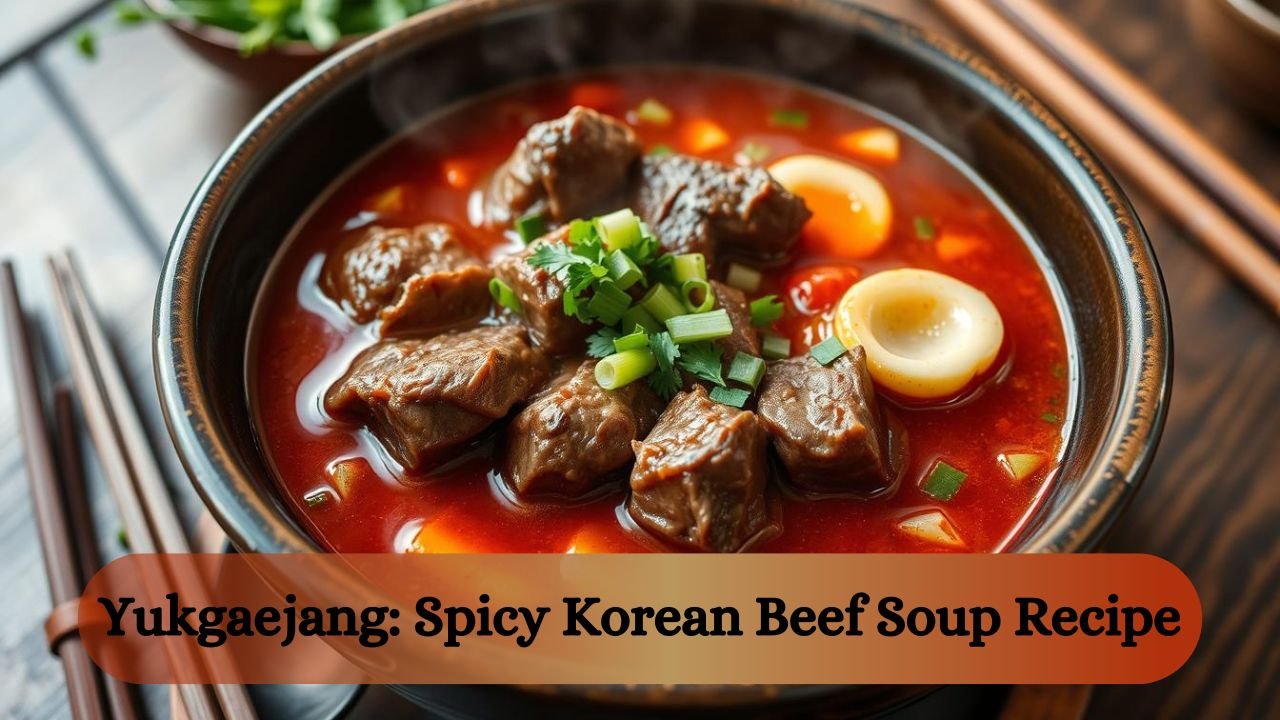One of the most popular dishes in Korean cuisine is yukgaejang, also known as spicy Korean beef soup. It’s not like it’s a new phenomenon; people have been interested in it for years. This thick soup features hot broth, thinly sliced meat and chewy Korean glass noodles.
Follow the instructions in this recipe and learn to make authentic yukgaejang. It’ll take your taste buds to Korea and on a trip.
Key Takeaways

- Yukgaejang is a traditional Korean spicy beef broth but also consumed as a soup.
- The other ingredients of the beef soup include beef sliced so thinly that it is almost transparent, glass noodles, and a savory broth.
- With this recipe, you are certain to cook authentic Yukgaejang in the comfort of your own space.
- The recipe is so famous for the very ingredients that put together constitute full heartiness, comfort and heat.
- Yukgaejang is a traditional Korean ingredient, enjoyed by the Koreans for many years.
What is Yukgaejang (Spicy Beef Soup)?
Yukgaejang, short for yukgaejang, is the traditional Korean spicy stew that has been enjoyed for centuries. Amongst the warm, healthy foods which laborers and farmers in Korea enjoyed during extremely cold winters was this savory one. Nowadays, it is one of the hottest meals consumed by Koreans who love soups and spicy soups worldwide.
A Traditional Korean Delicacy
For an authentic yukgaejang, proper flavors and ingredients have to be used. With plenty of cattle bones and brisket to make the broth, it would only add an oddly striking tinge to the dish with the use of gochujang-Korean chili paste. In addition, garlic, onions, and scallions provide their respective aroma.

Flavors and Ingredients
In addition, it also contains Korean glass noodles, mushrooms, and other greens of your choice, which include fernbrake (gosari) or bracken fern (gosari). Mixing up the combination of these ingredients in the right proportion can give you a beef soup recipe and also a spicy Korean soup recipe.
“Yukgejang is a South Korean comfort food that warms the heart with its sweet, spicy and grainy flavors.”
Cooking Authentic Yukgaejang (Spicy Beef Soup)
Making Yukgejang at home is pretty easy and very rewarding. It all begins with searing the beef until soft. Then, you add gochujang and scallions to the broth for bold flavors. Make it spicy according to your preference for a perfect meal.
The beef’s slow cooking is key to a great Yukgaejang. I sear the beef first, then simmer it in a flavorful broth. The meat was soft and the flavors, rich. The spicy kick came from gochujang while soy sauce gave a sweet balance with fresh scallions.
The spice content will just be right. Add small amounts of gochujang and add more as needed. That way, you’ll have something spicy yet comfort food at the same time. Serve over steamed rice to make it the complete Korean beef stew.
Making Yukgaejang is an easy but very rewarding process. For example, beef is stewed on low fire till it becomes soft. This way, the broth seasoned with gochujang and scallions gives a powerful flavor profile. If you want a dinner that is perfect, adjust the spice to your liking.
FAQ’s
Yukgaejang: What is it?
Yukgaejang is the Korean spicy beef soup. It is cherished as a comfort food. It contains glass noodles, spicy broth, and thinly cut meat. Into this spicy broth are added sliced scallions, vegetables, and gochujang.
Which staple ingredients does Yukgaejang contain?
Korean glass noodles and beef, such as short ribs or brisket, are the key ingredients of yukgaejang. Gochujang, scallions, garlic, onions, mushrooms, and greens like bracken fern or fernbrake are also included.
How is traditional Yukgaejang prepared?
Beef is cooked until it’s soft to make Yukgaejang. The broth is flavored with gochujang, onion and other aromatics. Then, the food is seasoned with appropriate spices. It comes with vegetables and glass noodles.
Why is yuk gaejang, the popular Korean comfort food so popular?
Yukgejang is known for its nutritional filling and cardio qualities. It’s wonderful when both sweetness from the noodles and spiciness from the broth come together. The beef is tender. It is one of the most ancient dishes in the Korean dish catalog.
I could eat as much yukgaejang as I can.
This is a variation of yukgejang. I pound and soften the meat. After that, I cook at home for yukgejang. And then, I sauté aromatics, and also the gochujang in rich broth, I add to noodles and vegetables in the meal.

